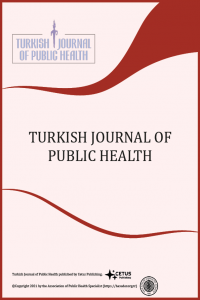SİGARAYLA MÜCADELEDE TIP EĞİTİMİNİN ROLÜ: TIP FAKÜLTESİ ÖĞRENCİLERİNDE SİGARA KULLANMA SIKLIĞI VE İLİŞKİLİ FAKTÖRLER, ÇANAKKALE
Sigara kullanımı, Sigara ile mücadele, Tıp eğitimi, Çanakkale
The role of medical education in smoking prevention: the prevalance of smoking and related factors in medical students, Çanakkale
Smoking medical students, Canakkale, Smoking Prevention, Medical Education,
___
- Tobacco, key facts, World Health Organization [online]. Available at: https://www.who.int/en/news-room/fact-sheets/detail/tobacco. Accessed June 25, 2019.
- Health Statistic Yearbook 2017, Republic of Turkey, Ministry of Health [online]. Available at: https://dosyasb.saglik.gov.tr/Eklenti/30148,ingilizcesiydijiv1pdf.pdf?0. Accessed May 10, 2019.
- Tobacco Use and Cessation Counseling-Global Health Professionals Survey Pilot Study, 10 Countries, 2005, Centers for Disease Control and Prevention, Morbidity and Mortality Weekly Report [online]. Available at: https://www.cdc.gov/mmwr/preview/mmwrhtml/mm5420a2.htm. Accessed May 10, 2019.
- Sreeramareddy CT, Ramakrishnareddy N, Rahman M, Mir IA. Prevalence of tobacco use and perceptions of student health professionals about cessation training: results from Global Health Professions Students Survey. BMJ Open. 2018;8(5).
- Global Health Professions Student Survey (GHPSS), World Health Organization Regional Office For Europe [online]. Available at: http://www.euro.who.int/en/health-topics/disease-prevention/tobacco/data-and-statistics/effective-surveillance-and-monitoring/global-tobacco-surveillance-system-gtss/global-health-professions-student-survey-ghpss. Accessed May 10,2019.
- Global Tobacco Surveillance System Data (GTSSData), Centers for Disease Control and Prevantion [online]. Available at: https://nccd.cdc.gov/GTSSDataSurveyResources/Ancillary/Documentation.aspx?SUID=3&DOCT=1. Accessed May 22, 2019.
- Sönmez CI, Başer DA, Aydoğan S. Evaluation of knowledge, attitudes, behaviors and frequency of smoking among medical students of Düzce University. Konuralp Medical Journal. 2017;9:83-89.
- Günbatar H, Sertoğullarından B, Ekin S. Smoking survey results on medical school students of Yuzuncu Yil University. Van Med J 2014;21:29-33.
- Arsava BE, Demir AU, Yüksek Ü, Atalay K, Aydemir AN, Çöplü L. Smoking prevalance among medical students and the influence of medical training. Turkiye Klinikleri Arch Lung 2013;14:61-65.
- Marakoğlu K, Toprak D, Şensoy N. The relationship between smoking status and depression prevalence in medical students. The Medical Journal of Kocatepe. 2006;7.
- Baykan Z, Naçar M. Smoking prevalence and views about tobacco law in students of medical school. Dicle Med J 2014;41:483-490.
- Arslan YT, Pirinçci S, Okyay P, Döger FK. Tobacco use and related factors among Adnan Menderes University Faculty of Medicine freshers. Meandros Med Dent J 2016;17:146-152.
- İnandı T, Caman OK, Aydın N, et al. Global Health Professions Student Survey-Turkey: Second-hand smoke exposure and opinions of medical students on anti-tobacco law. Cent Eur J Public Health 2013;21:134–139.
- Yang T, Yu L, Bottorf JL, et al. Global Health Professions student survey (GHPSS) in tobacco control in China. Am J Health Behav 2015;39:732-741.
- Ferry LH, Grissino LM, Runfola PS. Tobacco dependence curricula in US undergraduate medical education. JAMA 1999;282:825-829.
- Armstrong GW, Veronese G, George PF, Montroni I, Ugolini G. Assessment of tobacco habits, attitudes, and education among medical students in the United States and Italy: a cross-sectional survey. J Prev Med Public Health 2017;50:177-187.
- Tezcan S, Yardım N. Prevalence of smoking between the doctors, nurses and medical faculty students at some health facilities in Turkey. Tuberk Toraks 2003;51:390-397.
- Vatan İ, Ocakoğlu H, İrgil E. Determining smoking prevalence among Uludag University Faculty of Medicine. TAF Prev Med Bull 2009;8:43-48.
- Kartal M, Mıdık Ö, Büyükakkuş A. Tobacco smoking and its effect on quality of life of medical students in Ondokuz Mayıs University. Turk Thorac J 2012;13:11-17.
- Global Youth Tobacco Survey 2017, Republic of Turkey, Ministry of Health [online]. Available at: https://hsgm.saglik.gov.tr/depo/birimler/tutun-mucadele-bagimlilik-db/duyurular/KGTA-2017_pdf.pdf. Accessed July 15, 2019.
- Brimkulov N, Vinnikov D, Dzhilkiadarova Z, Aralbaeva A. Tobacco use among Kyrgyzstan medical students: an 11-year follow-up cross-sectional study. BMC Public Health 2017;17:625.
- San-Pedro EM, Roales-Nieto JG, Blanco-Coronado JL. Tobacco use among Spanish phsicians and medical students. Tob Control 2006;15:272.
- Başlangıç: 2003
- Yayıncı: Halk Sağlığı Uzmanları Derneği
Neslişah ŞİYVE, Ahmet Naci EMECEN, Salih KESKİN, Ecem BAŞOĞLU ŞENSOY, Öykü TURUNÇ, Ahmet Furkan SÜNER, Can CİMİLLİ, Belgin ÜNAL
Petek Eylül TANERİ, Murat CİVANER
COVID-19 Aşı Tereddütü ve Aşı Yaptırmayan Bireylerin Negatif Tutum Algıları: Nitel Çalışma
Buse YÜKSEL, Esen GOKCE, Coşkun BAKAR, Demet Güleç ÖYEKÇİN, Yagmur DUVA
Whyelian CHEAH, Leh Shii LAW, Su Bo MYAT, Abigail Eleanor GANİ, Andy, Yueh Lee LAU, Mechyle ABİNG, Nur Nadhirah Aisyah MOHD YASİN
Mücahid Alp ARSLAN, Erol GÜRPINAR, Levent DONMEZ
The impact of healthy lifestyle behaviors on productivity at work: A factory example
Elif SARAÇ, Esra YILDIZ, Deniz ÇALIŞKAN
Ayşe BULUT, Arzu FIRLARER, Nevra KARAMÜFTÜOĞLU
Kanser Damga Ölçeği'nin Türkçe Geçerlik ve Güvenilirliğinin Değerlendirilmesi
